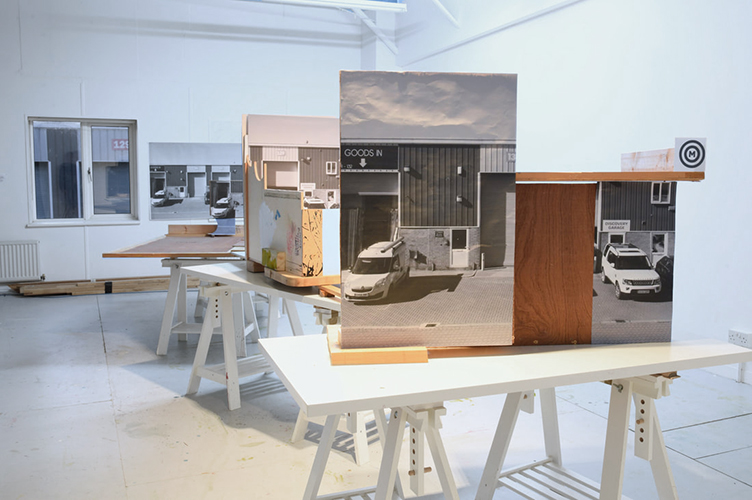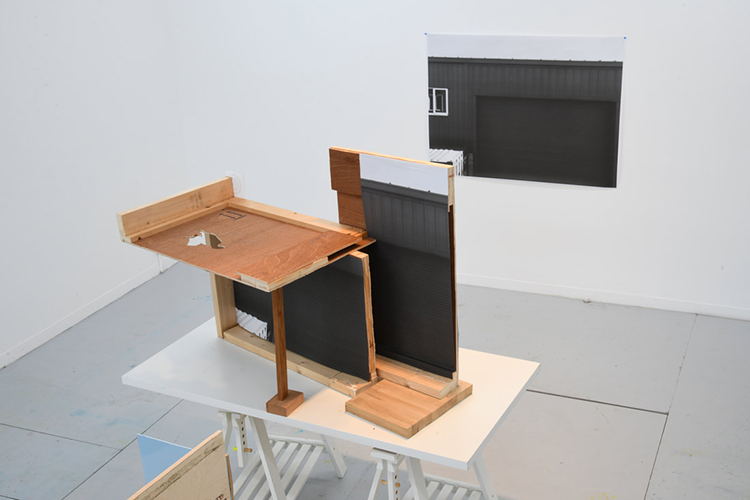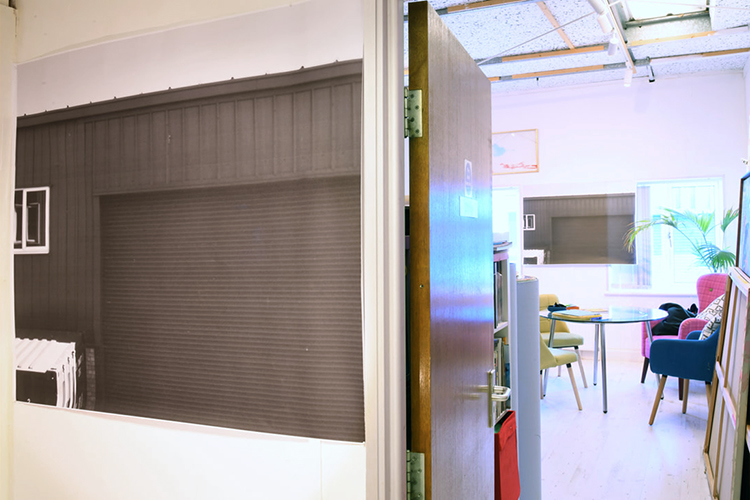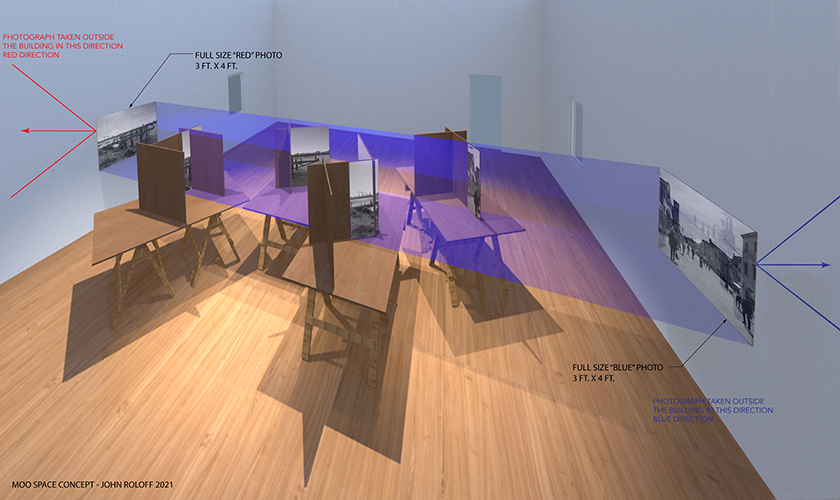?‘Vistula’ *
The Alchemy of John Roloff
Watch what you ask for when your friend is an alchemist. It was always one of my strong wishes to have a museum without walls. What I meant by ‘without walls’ was of course that anybody could see in. I never considered what it must feel like from the other side, when you are in and looking out.
John Roloff’s alchemy has transformed the Museum of Openness (Moo) into a museum without walls. For his installation ‘Vistula’, he had asked me to look outside the front of my studio (facing north), take a photo, and to look out to the back of the studio (facing south) and take another photo. A few weeks later 12 large prints arrived from California. Six of the prints show the view outside the front, and the remaining six are views in the opposite direction. These prints were then placed on all of the walls on this north-south axis in both directions: the Moo walls, the studio walls, and even on the kitchen, corridor and the bathroom walls. As part of this, the actual Moo structure was dismantled, and its walls were spread out on 3 tables across the studio.
The effect of the twelve layers that cut across the space is surprising. The building seems to expand beyond its walls and opens to the outside, not by looking through the windows but by bringing the immediate exterior views inside.
These views, seen on the prints, appear to be floating on various planes while the studio room itself the very much grounded, anchored in place. The end result is that the Moo appears more ‘out’ than ‘in’, an interlocking puzzle, where space appears to extend indefinitely.
This brings to mind this past year; the experience of the Covid-19 lockdown and an overwhelming sense of being confined. Countries around the world had enforced lockdowns of varying stringency, which included movement control, while others have enforced restrictions based on time. The world became smaller, time stood still, yet also seemed infinite and ongoing. Because the internet has no physical boundaries, most of us either reluctantly or pragmatically attempted to carry on. It was survival. Besides functional and practical activities of conducting business, remote teaching, internet shopping etc., we sought to extend our desire for social and meaningful human interactions via Zoom, with illusions of birthday parties, weddings or funeral gatherings, concerts and exhibitions.
What John Roloff has done with his project ‘Vistula’ is to point out that we see reality as we wish to, that our perception is easily fooled. Magic or make-believe? I am more inclined to go for alchemy, a form of speculative thought that, among other aims, tries to transform base metals such as lead or copper - or in this case my thought of a museum - into silver or gold or, in this case, into openness.
When asked specifically which view to capture, John insisted on requesting the most unspectacular. Here, now, outside, nothing else! I offered more aromatic locations only a mile away, spectacular ocean shores with clouds or cherry orchards in full blossom on the afore mentioned north-south axis. “No, just the immediate outside in your industrial estate and maybe an indication of where you took the photos from.” The man thinks like a scientist I thought, where will this end? I didn’t consider the view of this industrial estate to be material for art, dramatic or romantic. On the other hand, I have to admit that I always considered the same shabby sheds utterly romantic when they appeared in New York or John’s Bay Area in California. Lesson No 1: The grass is always greener on the other side.
Lesson No 2: no matter how small- this is a real location. While almost everything became virtual during lockdown - and my Museum Openness is a product of such a remote love for life - looking out of the window now and taking in the view that John has drawn my attention to, I see that this is a real place. The museum exists in a real place even if you might only see it on screen, it is on Harvey Drive in the John Wilson Business Park in Whitstable. Love it or hate it, it’s here.
|
An alchemist is someone who transforms things for the better, I read in the dictionary. Looking down a list of alchemists, I find the name of Paracelsus (1493-1541) and even of Isaac Newton (1643-1727) with astonishment. While of course nowadays alchemy is seen as a pseudoscience by most - giving chemistry its rightful place as a serious scientific field - the two terms initially overlapped in meaning before getting separated by the 17th century, just as astrology and astronomy did during the same period. The long route of the word ‘alchemist’ into the English language began with the Greek word ch?meia, which probably came from the word chyma (‘fluid’), derived from the verb chein, meaning ‘to pour’. It then passed to Arabic, which added its definite article al- (‘the’) to the Greek root. The word then passed from Latin to French before finding a place in the English language. Some other words derived from Arabic also retain the al- in English, such as algebra, algorithm, and alcohol; in fact, the transformative liquid that was constantly being sought through experimentation by alchemists is another word that originated from the Arabic al-prefix: elixir. This power to transform things for the better, whether real or imagined, led to figurative meanings of alchemy including the word ‘transmutation’.
Is John Roloff’s conceptual artwork for the Moo a transmutation? A term more familiar with nuclear scientists than with art, but let’s steal the term for a moment. Some common synonyms of transmute are convert, metamorphose, transfigure, transform, and even transmogrify, meaning to alter with grotesque or humorous effect. While all these words mean "to change a thing into a different thing," to transmute implies transforming something into a higher element.
What is the higher element here? The awareness of the HERE and NOW? The Buddhist’s wish to overcome our mind, which struggles to be in the present, as it constantly flips between the past or the future? Or is it that through Roloff’s inversion of the space, he opens the door to see space as an illusion?
If John Roloff would be a philosopher, he would argue his case. But he is not.
The layers of thought do not have to follow an argument as long as they are coherent in themselves. We are not looking at nature and we are not looking at another world like the ones I have created in previous exhibitions. Openness is created in a physical sense not in an intellectual one. It does not entertain with the solution but creates the question.
John Roloff’s installation requires time to resonate. It is quite a switch from the previous endeavours at the Moo. As old habits are hard to break, I frequently find myself wanting to add stones that I picked up on my daily walks by the seashore. I guess they are some form of archaeological memory, which help to ground the museum so that the whole place doesn’t just fly away, lesson No 3!
Alf Löhr
*‘The title ‘Vistula’ is a metaphor caught between Heraclitus’s river, his portrayal of the dilemma of change, and the mystery of my family’s early location in Germany, possibly Prussia. ‘John Roloff.
|







